
Guests
- Andrew McEnteean international human rights lawyer who traveled to Afghanistan in the fall of 2002 to investigate the massacre.
One of Afghanistan’s most feared warlords has returned to Afghanistan just days before its presidential election. General Abdul Rashid Dostum is one of several warlords who have allied with Afghan President Hamid Karzai, who is seeking a new term. Karzai is hoping Dostum’s return will help attract ethnic Uzbek voters. Dostum’s return to prominence in Afghanistan comes despite his role overseeing a 2001 massacre at Dasht-e-Leili that left at least 2,000 Taliban POWs dead. He’s also had extensive ties with the US and was formerly on the CIA payroll. We speak with international human rights lawyer, Andrew McEntee. [includes rush transcript]
Transcript
SHARIF ABDEL KOUDDOUS: One of Afghanistan’s most feared warlords has returned to Afghanistan just days before its presidential election. General Abdul Rashid Dostum is one of several warlords who have allied with Afghan President Hamid Karzai, who is seeking a new term. Karzai is hoping Dostum’s return will help attract ethnic Uzbek voters.
On Monday, Dostum addressed a rally in the northern Afghan city of Sheberghan. His message of support for Karzai also contained a warning to his opponents.
GEN. ABDUL RASHID DOSTUM: [translated] We are hopeful. We are determined. Playing with General Dostum is playing with a million human beings. Playing with General Dostum is playing with a storm. Playing with General Dostum will be tough and will create anger. God willing, we will establish a party in Afghanistan which will be bigger and stronger within six years, and this party will be able to respond to your demands. And this is what you and your martyrs deserve.
SHARIF ABDEL KOUDDOUS: Dostum’s return to prominence in Afghanistan comes despite his role overseeing a 2001 massacre at Dasht-e-Leili that left at least 2,000 Taliban POWs dead. He’s also had extensive ties with the US and was formerly on the CIA payroll.
Last month, New York Times reporter James Risen revealed the Bush administration blocked at least three federal investigations into the alleged war crimes committed by Dostum. Risen spoke about his findings on Democracy Now!
JAMES RISEN: The evidence was overwhelming that something had happened and that it was the responsibility of the Bush administration to look into this or at least to push for an international investigation, because Dostum had been on the CIA payroll, was part of a US-backed alliance that was taking over Afghanistan. And what I found was, time after time, in different agencies and as far — and in the White House, Bush administration officials repeatedly ignored evidence or just decided or discouraged efforts to open investigations into the massacre.
SHARIF ABDEL KOUDDOUS: After the new findings came to light, CNN’s Anderson Cooper asked President Obama about opening a new investigation into the Bush administration’s alleged cover-up.
ANDERSON COOPER: Some were suffocated in a steel container. Others were shot, possibly buried in mass graves. Would you support — would you call for an investigation into possible war crimes in Afghanistan?
PRESIDENT BARACK OBAMA: You know, the indications that this had not been properly investigated just recently was brought to my attention, so what I’ve asked my national security team to do is to collect the facts for me that are known, and we’ll probably make a decision in terms of how to approach it once we have all the facts gathered up.
ANDERSON COOPER: But you wouldn’t resist categorically an investigation?
PRESIDENT BARACK OBAMA: I think that, you know, there are responsibilities that all nations have, even in war. And if it appears that our conduct in some way supported violations of the laws of war, then I think that we have to know about that.
AMY GOODMAN: On Monday, the State Department said the Obama administration continues to gather evidence on Dostum’s alleged role in the Dasht-e-Leili massacre. Assistant Secretary of State for Public Affairs P.J. Crowley said the US had expressed, quote, “serious concerns” to the Afghan government about Dostum’s return.
For more on this story, we’re going to London now, where we’re joined by Andrew McEntee. He is an international human rights lawyer who traveled to Afghanistan in the fall of 2002 to investigate the massacre. Andrew is also the former chair of Amnesty International UK.
Andy, welcome to Democracy Now!
The significance of Dostum’s return on the eve of the Afghanistan elections to support President Karzai in his bid to be reelected?
ANDREW McENTEE: Well, I think that the significance is quite clear if you’ve ever been to northern Afghanistan, where General Dostum’s role, I think, this week is to deliver the Uzbek, ethnic Uzbek, votes for President Karzai. It’s as simple as that. And the best way of doing that is to have him back home in Afghanistan.
SHARIF ABDEL KOUDDOUS: And you traveled to Afghanistan to investigate this massacre. Describe exactly what happened. These prisoners surrendered. They were transported. Go through the events that took place.
ANDREW McENTEE: Well, I’d like to say first that I was introduced to this issue by the filmmaker and journalist Jamie Doran, who had investigated with his film crew in northern Afghanistan in late 2001 into early 2002. And Jamie approached me in London and asked me to look at his film footage and other evidence he had to make a human rights assessment, some legal assessments, partly about culpability responsibilities, partly to help him fill the gaps in the storyline.
And very quickly after reviewing several hours’ worth of film footage of the grave site at Dasht-e-Leili, of interviews, translated transcripts of the interviews, as well, of people who had been there, people who had driven the transport, people who had actually claimed that they had killed some of the prisoners, very quickly the story held up.
What surprised me, though, was the strand which went through which is in some ways the most contentious strand, which is that there was some involvement or at least some responsibility for many of the deaths on the part of US Special Forces who were on the ground at the time, as well. And I think that when you look at the story, the story itself is big enough. More than 2,000 people in a mass grave under one incident that took place — well, it took place over a number of days, but it was one continuing incident — that is big enough in itself for any war, any series of war crimes in any country in any decade. The problem with this issue, though, has been precisely the fact that US Special Forces were on the ground and that they had command responsibility. They had command over many of the guys, the Afghan soldiers, who began the killing.
And the problem continues to be —- and I full understand the problem that defense departments have and the White House has had over the years. The problem continues to be that over the days when the bodies were rolling out of these trucks in Sheberghan prison, US Special Forces could have stopped it. And the big question for me has always been, why did they not stop it? They had control over the actions of the Afghan soldiers. They were the top of the command structure, and yet they continued to let it happen. And in particular -—
AMY GOODMAN: Were they there?
ANDREW McENTEE: Well, at first they denied they were there. And that was interesting, because I had seen photographs showing they were there, and there was other evidence they were there. So the storyline changed and said, well, yeah, they were there, but they weren’t there when the trucks rolled through the gates, and they weren’t there when the bodies spilled out of the backs of the trucks, and they certainly weren’t there when the bodies were being tipped into pits on the edge of the desert. And bit by bit, the evidence seems to show that in fact they were there, they did know, they must have known.
One of the keys to this is that the reason that the two, three thousand men who died were being taken from Kalai Zeini to Sheberghan prison before being sent home, because the war had finished, the fighting had finished, the reason they were being taken was that US Special Forces interrogators were still looking for al-Qaeda operatives, and they feared that some of the operatives were hiding amongst these guys. So their idea was to identify them, to take them to wherever, which ultimately would have been Guantanamo in some cases, because they were an intelligence asset. And the US special interrogators must have known in the first day, at the prison where they were stationed, that hundreds of bodies were spilling out of metal containers, dead through suffocation.
Why they didn’t then stop that in the subsequent days, when these container trucks were rolling back down to where they began to pick up another batch of prisoners and rolling back, and more were spilling out — why didn’t stop it? That, to me, is the big question. Negligence, for sure, but criminal negligence.
SHARIF ABDEL KOUDDOUS: And finally, General Dostum himself, his role in this massacre — these were his forces — and also his connection to the United States?
ANDREW McENTEE: Yeah, well, this is where it gets a much more — a broader picture shows you the realities on the ground at the time. The whole area of Mazari Sharif and Sheberghan and so on were the vital strategic assets for the military forces on each side, so it was imperative for the allies, United States and their allies, to come in and control the area. And it was very clear from the recent history of Afghanistan that the only way you could do that is if you had General Dostum on your side.
Now, General Dostum is a character who — he flips from one side to the other. His allegiance goes depending on whether he will win if he flips his allegiance or whether he’s going to get paid more. So he was paid buckets full of dollars over a long period of time, and he was an ally. And he effectively won the war in the north and gained control of the north — Mazari Sharif, Sheberghan — for the US and their allies. And that was the importance of Dostum. And because of that military importance, everything else was overlooked.
The problem in the years since then, of course, has been that Dostum is a very contentious fellow. And I think it’s worth explaining to people that when you refer to people like Dostum as warlords, you’re not talking about a gang leader, you know, someone who lives out of a small hut and controls a village; you’re talking about someone who effectively controls a military operation, which controls a major part of the state territory. He has guns. He has armored vehicles. He has light aircraft. He has everything.
And he continues, even now, to be an important political, but also military, figure in the north of Afghanistan. And that was why it was quite important for him to be out of the country, because on the political side, he is ethnically an Uzbek. Uzbekistan borders to the north of Afghanistan. And his role for President Karzai clearly was to deliver Uzbek voters for Karzai. And the reason being that — I mean, although personally I think Karzai is going to come out in the first round of the election with the highest number of votes, what President Karzai clearly needs for his credibility is to win the presidency in the first round, which requires 50 percent of the votes cast plus one. Otherwise, it goes to a second round. And that’s why I think Dostum is back. Dostum’s job is to deliver as many votes of — from the Uzbek ethnic community in Afghanistan as possible to help Karzai reached the 50 percent plus one target.
AMY GOODMAN: Andrew McEntee, we want to thank you very much for being with us, formerly head of Amnesty International in the UK.
As we turn now to an excerpt of the documentary you referred to, Afghan Massacre: Convoy of Death by the award-winning Irish filmmaker Jamie Doran, who traveled to the site of the massacres and the mass graves in 2002 in Afghanistan. The witnesses who testified in the film are unidentified and have their faces obscured. Two of them have since died. This excerpt begins with a description of how the prisoners were transported in containers.
JAMIE DORAN: Originally loaded onto trucks at Kunduz, many of these men were crammed two to three hundred at a time into the backs of sealed containers. After around twenty minutes, the prisoners began crying out for air.
EYEWITNESS: [translated] The weather was very hot. They put too many people inside the containers. Many died because there was no air.
INTERVIEWER: [translated] How many containers were at Kalai Zeini when you left?
EYEWITNESS: [translated] There were about twenty-five containers. The condition of them was very bad, because the prisoners couldn’t breathe, so they shot into the containers, and some of them were killed.
TRUCK DRIVER: [translated] They told us to stop the trucks, and we came down. After that, they shot into the containers. Blood came pouring out of the containers. They were screaming inside.
JAMIE DORAN: One Afghan soldier admits that he personally murdered prisoners.
AFGHAN SOLDIER: [translated] I hit the containers with bullets to make holes for ventilation, and some of them were killed.
JAMIE DORAN: You specifically shot holes into the containers. Who gave you those orders?
AFGHAN SOLDIER: [translated] My commanders ordered me to hit the containers to make holes for ventilation, and because of that, some prisoners died.
JAMIE DORAN: But this was no humanitarian gesture. Rather than shooting into the roofs of the containers, the soldiers fired at random, killing those nearest the walls. A local taxi driver had called in at a petrol station on the road to Sheberghan.
TAXI DRIVER: [translated] I smelled something strange and asked the attendant where the smell was coming from. He said, “Look behind you.” There were three trucks with containers fixed on them. Blood was running from the containers.
AMY GOODMAN: An excerpt of Afghan Massacre: Convoy of Death by the award-winning Irish filmmaker Jamie Doran, who traveled to the massacre sites. The notorious warlord Dostum has been invited back to Afghanistan on this eve of the election by the incumbent President Hamid Karzai to win — to help him win reelection.


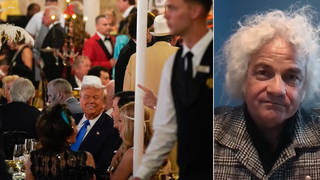
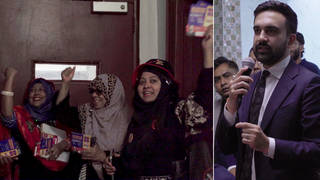
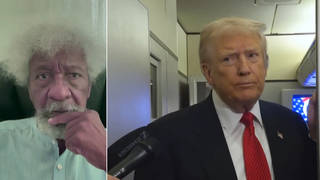





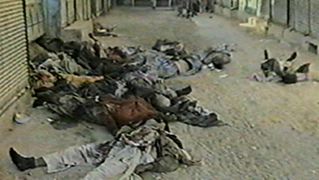
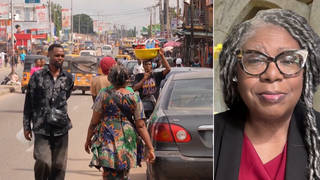
Media Options